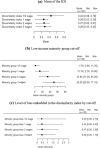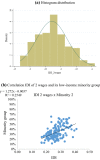Inequality and income segregation in Brazilian cities: a nationwide analysis
- PMID: 36105865
- PMCID: PMC9464061
- DOI: 10.1007/s43545-022-00491-9
Inequality and income segregation in Brazilian cities: a nationwide analysis
Abstract
Residential segregation has brought significant challenges to cities worldwide and has important implications for health. This study aimed to assess income segregation in the 152 largest Brazilian cities in the SALURBAL Project. We identify specific socioeconomic characteristics related to residential segregation by income using the Brazilian demographic census of 2010 and calculated the income dissimilarity index (IDI) at the census tract level for each city, subsequently comparing it with Gini and other local socioeconomic variables. We evaluated our results' robustness using a bootstrap correction to the IDI to examine the consequences of using different income cut-offs in substantial urban and regional inequalities. We identified a two minimum wage cut-off as the most appropriate. We found little evidence of upward bias in the calculation of the IDI regardless of the cut-off used. Among the ten most segregated cities, nine are in the Northeast region, with Brazil's highest income inequality and poverty. Our results indicate that the Gini index and poverty are the main variables associated with residential segregation.
Supplementary information: The online version contains supplementary material available at 10.1007/s43545-022-00491-9.
Keywords: Brazil; Income dissimilarity index; Segregation; Urban inequality.
© The Author(s) 2022.
Conflict of interest statement
Conflict of interestWe declare no competing interest.
Figures






References
-
- Akita T. Decomposing regional income inequality in China and Indonesia using two-stage nested theil decomposition method. Annals of Regional Science. 2003;37:55–77. doi: 10.1007/s001680200107. - DOI
Grants and funding
LinkOut - more resources
Full Text Sources
